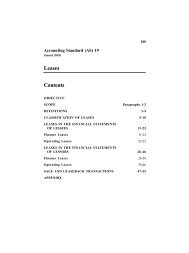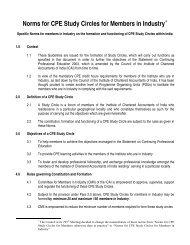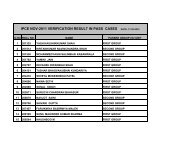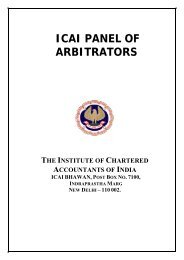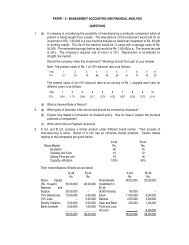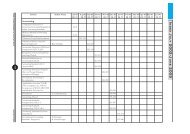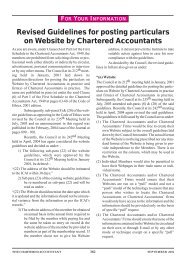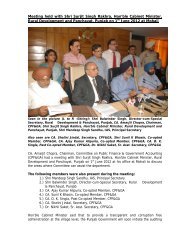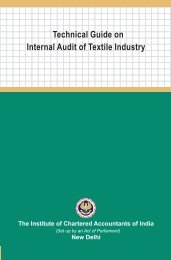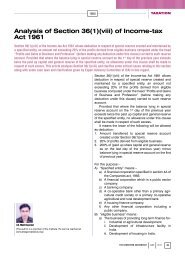The Chartered Accountant
The Chartered Accountant
The Chartered Accountant
Create successful ePaper yourself
Turn your PDF publications into a flip-book with our unique Google optimized e-Paper software.
consonance with the Standards prescribed<br />
by the Institute. Similarly, nothing prevents<br />
the Central Government from adopting the<br />
Standards issued by that Institute as is the<br />
case in the present matter. <strong>The</strong>refore, in<br />
our view, the impugned rule is valid as<br />
it has nexus with the statutory functions<br />
entrusted to the rulemaking authority,<br />
namely, the Central Government”<br />
(Para79 on page 273 of 297 ITR)<br />
<strong>The</strong> Honourable Supreme Court then went on the next<br />
point -<br />
“(b) Whether the impugned rule is incongruous/contrary<br />
to sections 209 and 211 read<br />
with the provisions of Part I and Part II of<br />
Schedule VI to the Companies Act, 1956,<br />
and whether the said rule seeks to modify the<br />
essential features of the Companies Act?”<br />
and held as under-<br />
“<strong>The</strong>refore, in our view, rules framed under<br />
section 641 followed by the rules framed under<br />
section 642(1) shall continue to be rules<br />
subordinate to the Companies Act though<br />
for the purposes of construction, they are<br />
to be treated as forming part of the same<br />
scheme. (Para100 on page 283 of 297 ITR)<br />
“Applying the above test to the present case,<br />
we are now required to interpret the words<br />
"the amount of charge for Indian incometax<br />
on profits" in clause 3(vi) in Part II of<br />
Schedule VI to the Companies Act. Similarly,<br />
we are required to interpret the words "current<br />
liabilities and provisions" in the form of<br />
balance-sheet in Part I of Schedule VI to the<br />
Companies Act. Part III of the said Schedule<br />
defines the words "provision" as well as<br />
"reserve".<br />
As stated above, the form of balance-sheet<br />
is prescribed by Part I of Schedule VI. <strong>The</strong><br />
Act does not prescribe a proforma of profit<br />
and loss account. However, Part II of Schedule<br />
VI prescribes the particulars which must<br />
be furnished in a profit and loss account. As<br />
far as possible, the profit and loss account<br />
must be drawn up according to the requirements<br />
of Part II of Schedule VI. As stated<br />
above, section 211(1) emphasizes "true and<br />
fair" view in place of true and correct view<br />
of accounting. As stated above, the legisla-<br />
DECEMBER 2008 970 THE CHARTERED ACCOUNTANT<br />
ACCOUNTING<br />
tive policy is to obliterate the difference between<br />
the accounting income and the taxable<br />
income. As stated above, the accounting income/book<br />
profit is the real income. <strong>The</strong>refore,<br />
section 211(1) emphasizes the concept<br />
of "true and fair" view. As stated above, it is<br />
a standalone consideration. It is the controlling<br />
element underlying the scheme of sections<br />
209, 211 and 227. However, as stated<br />
above, the Companies Act does not deal<br />
with recognition, measurement and<br />
disclosure. As stated above, how much<br />
amount should be recognized in respect<br />
of a specific matter is not covered by<br />
section 209(3)(b). Recognition, measurement<br />
and disclosure are the three items<br />
which can only be done by way of Accounting<br />
Standards and not by the provisions<br />
of the Companies Act. This aspect is<br />
important because under section 642(1) the<br />
Central Government is empowered to carry<br />
out ancillary/subordinate legislative functions<br />
which is also fictionally called as power<br />
to fill up the details. Under section 211(1),<br />
Parliament has laid down the controlling<br />
consideration in presentation of balancesheet<br />
and profit and loss account by companies<br />
and it has thereafter conferred discretion<br />
on the Central Government to work out<br />
details within the framework of that policy.”<br />
(Paras118-119 on page 286 of 297 ITR)<br />
“<strong>The</strong> words "tax expense" in paragraph 9<br />
under conservative system of accounting<br />
were confined to current tax. However, with<br />
paragraph 9 of AS 22 coming into force,<br />
the words "tax expense" now include both<br />
current tax and deferred tax. This inclusion<br />
became necessary because of developments<br />
not only in concepts but also in accounting<br />
practices. This inclusion becomes necessary<br />
if one has to go by the paradigm shift from<br />
historical costs accounting to fair value principles.<br />
In our view, with the insertion of the<br />
words "true and fair" view in section 211,<br />
which is the requirement in the matter of<br />
presentation of the balance-sheet and the<br />
profit and loss account the rulemaking authority<br />
was entitled to include the concept of<br />
deferred tax in tax expense. It may be stated<br />
that under clause 3(vi) of Part II, Schedule<br />
VI the charge for tax on profit is contemplated.<br />
<strong>The</strong> provision for liability for taxation



